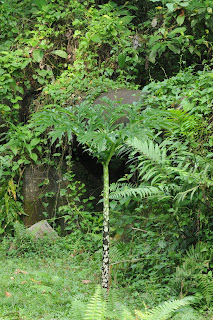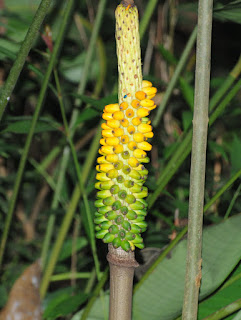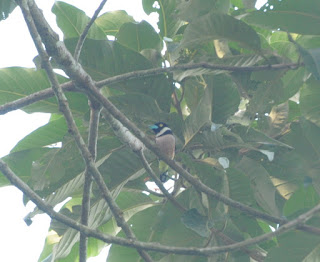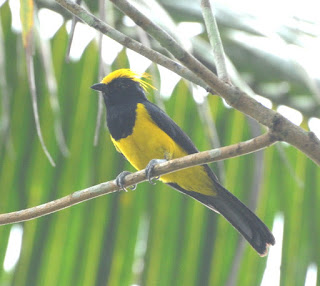
It's a very pleasant spot, especially considering that it is practically on the edge of Kuala Lumpur. The birding (and, for once, the bird photography) was pretty good, too. There is a trail to the peak - a stiff two-hour hike that we did not take. Instead, we contented ourselves with a shorter uphill stroll along a trail that followed hydro right-of-way up into the forest, followed by some very fruitful explorations of the orchard (no pun intended) and picnic ground near the parking lot.

Along the forest trail, we found a number of interesting plants, including a fig sprouting fruits directly from its massive trunk (a phenomenon called cauliflory, typical of many figs, that I have often illustrated here).
Not precisely a plant: an attractive white Fungus sprouting from some fallen wood.
This is a common species of ginger, one of many in Malaysia - a member of the genus Zingiber, the one containing commercial ginger (Zingiber officinale). This is probably Zingiber spectabile, which comes in yellow, red or pink. The yellow objects are inflorescences; the flowers, when they are present, poke out above the yellow scale-like structures.

This is an actual flower, not an inflorescence.


Here is, certainly, the oddest plant along the trail. It is a Voodoo Lily or Elephant Yam (Amorphophallus - there are several species in Malaysia), one of several individuals that we saw. What you are looking at is a single, much-divided leaf - the only ne he plant produces - borne on a thick, mottled stalk. Amorphophallus species are most famous for their enormous inflorescences; that of the Sumatran A. titanum is one of the largest (and, apparently, smelliest) on any plant, growing to three metres in height on the rare occasions when it blooms.
You will often see Amorphophallus described as having oneof the world's largest flowers, but this is inaccurate. The inflorescence (as in all aroids) is not a flower, but a supporting structure for many very small and inconspicuous flowers. We were not lucky enough to be there in the flowering season (for the inflorescence of this species see here), but we did happen across a fruiting stalk. Here the true nature of the inflorescence is easier to see - each of the yellow or greenish fruits is the product of a single flower, arranged on the remains of what is now properly called not an inflorescence (as the flowers are gone) but an infructescence.
We did not see much in the way of bird life on the trail, but I did spot this damselfly - a female of one of the Vestalis species.
Back at the parking lot area, in more open surroundings, insects and birds were much easier to see and approach. Identifying them (without having them in the hand to check details) is another matter. This dragonfly is an Orthetrum (ignore the file name on the photo, which is wrong), and I think it is Orthetrum testaceum - but it could be Orthetrum chrysis, though in that species the thorax is usually brown. They are very similar.
I thought at first that this one actually was Orthetrum chrysis. It probably still is one (or I suppose it could be another testaceum), but notice the faint bluish tinge on the thorax. That may make it an immature Orthetrum pruinosum, yet to develop the brown patch at the base of the hindwing and the bluish cast, or pruinosity, over the first segment or two of the abdomen that characterize mature adults. [July 2017: this appears to be Lyriothemis cleis].
This one is easier: a very blue adult Orthetrum glaucum.
And this is easier still: Orthetrum sabina (we've seen this one before!).
For a change, a dragonfly that is not an Orthetrum: Trithemis festiva (note the orange patches on the otherwise dark-blue abdomen).

This is a day-flying moth of the genus Nyctemera (Arctiidae), probably Nyctemera coleta - one of a group known as Marbled Whites. N. coleta is a common second-growth species across much of south and south-east Asia (according to information I cribbed from a very nice gallery of Malaysian moths).
On to butterflies. First, two danaiines: the Magpie Crow (Euploea radamanthus, named after one of the judges of the ancient Greek underworld - I guess because it's dark)...
…and the Yellow Glassy Tiger (Parantica aspasia aspasia).
There are a number of tiny but spectacular hairstreaks, in different genera, that look like this one. I believe it is a Dark Posy (Drupadia theda thesmia).
One of a large group of very similar skippers known as "darts" (Potanthus, Telicota and related genera). I have no idea which.

This is little better than a record shot, but broadbills are hard to resist. This is the commonest member of the family, the Black-and-yellow Broadbill (Eurylaimus ochromalus), whose shimmering duets are a common sound in the rainforest (seeing the birds is a bit trickier).
Here we perceive the advantages of bird photography, even if the results are not exactly ready for publication in National Geographic. I took one of these photos fairly early in our stroll around the picnic area, and the other - in almost the same spot - a short time later. I had assumed that I was looking at the same individual. It was only when I got back to my computer that I discovered that these two spiderhunters were not only different individuals, but different species. The differences are slight, but obvious if you bother (which I clearly hadn't) to look closely - notice in particular the length of the bill and the relative sizes of the yellow eye-ring and ear-patch. The upper bird is a Yellow-eared Spiderhunter (Arachnothera chrysogenys); the lower is a Spectacled Spiderhunter (Arachnothera flavigaster).
The trees in the little orchard were full of flowerpeckers, but they were difficult to photograph. This is a Yellow-vented Flowerpecker (Dicaeum chrysorrheum).
This is a lousy photograph of a very plain little bird, but I include it as this isn't always an easy species to see: a Plain Flowerpecker (Dicaeum concolor).
Here, doing its best to eviscerate a caterpillar, is a Sultan Tit (Melanochlora sultanea), the world's largest and most spectacular chickadee.
It is a very handsome bird indeed - one I had previously only glimpsed near the tops of trees. This one was much more cooperative, and I was delighted to get on close terms with it.
While we watched birds, a young Water Monitor (Varanus salvator) kept an eye on us.
In return for Bing's hospitality and guide services, I had promised to talk about nature to her young students at the international school where she teaches (well, I would have done it anyway, and we had a lot of fun with the kids). To illustrate part of my talk, I brought a souvenir from Gunung Nuang (those are Bing's fingers holding it, not mine): the remarkable seed of a Javan Cucumber (Alsomitra macrocarpa), a climbing vine that is surely the ne plus ultra of wind-borne seed dispersal. Technically this is a samara, a winged seed like those of maples or dipterocarps, but it is a samara carried to extremes. Hundreds of them are crammed together into a giant pod, and when released - if wind conditions are right - they can glide immense distances across the forest with very little loss of altitude. Their structure has even influenced airplane designers, and their flights have been recorded for the BBC series Life. You can read about them here or, for the more technically inclined with access to a university library facility, here. You can also watch one being put through its paces on YouTube, or see the maiden voyage of a man-made equivalent.
With that, it was soon time for Eileen and I to do some flying on our own. After this long series of postings from New Zealand, Australia, and Malaysia, we will return in my next few posts - for a little while - to what Life Magazine once called "The Woods of Home", in Ontario, Canada.


































No comments:
Post a Comment